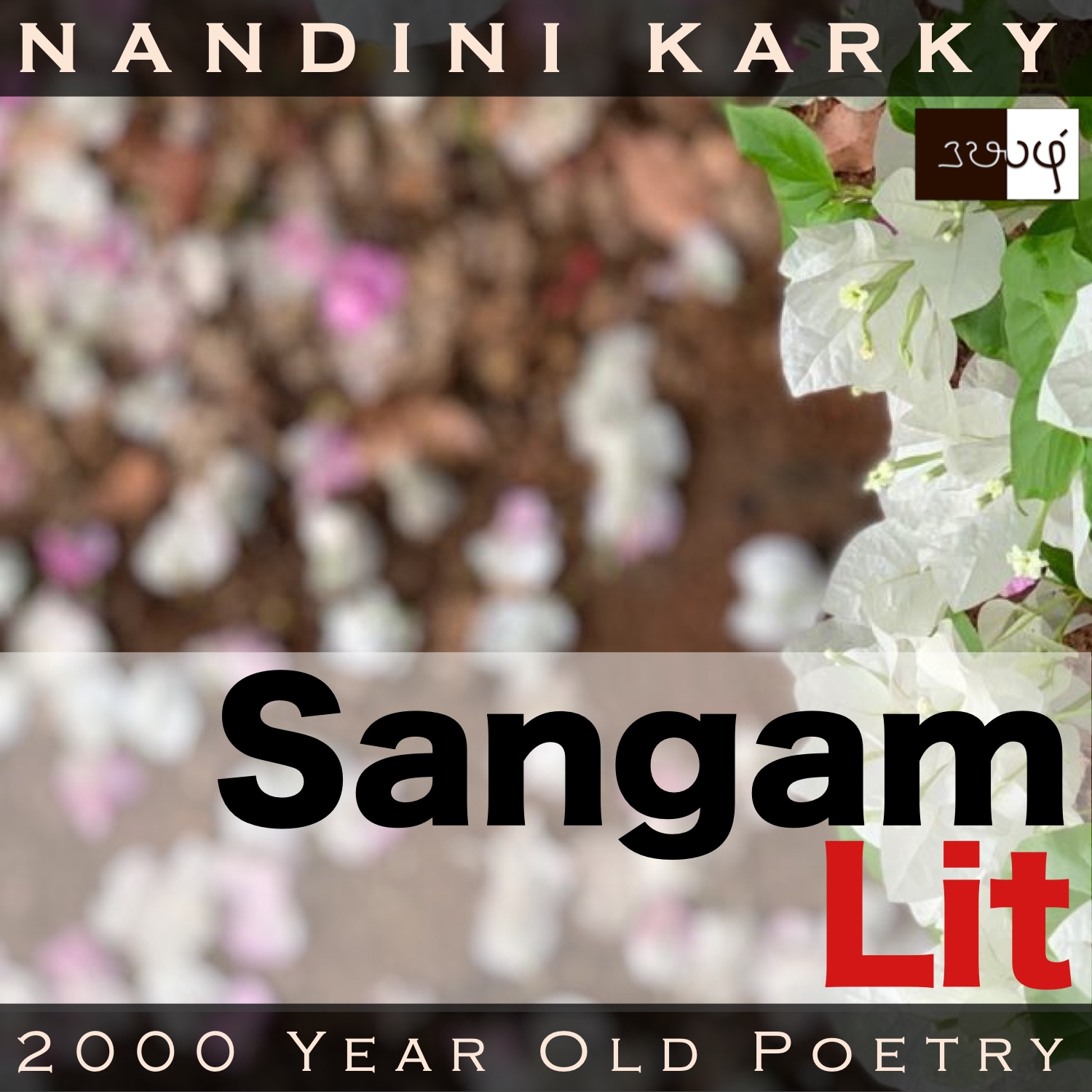Podcast: Play in new window | Download
Subscribe: Apple Podcasts | Spotify | Amazon Music | Android | iHeartRadio | Email | TuneIn | RSS | More

In this episode, we relish the rich visuals depicted in Sangam Literary work, Natrinai 124, written by Mosi Kannathanaar. Set in the coastal regions of ‘Neythal’ landscape, the verse speaks in the voice of the confidante to the man, bidding him to give up his plans of parting from the lady.
ஒன்று இல் காலை அன்றில் போலப்
புலம்பு கொண்டு உறையும் புன்கண் வாழ்க்கை
யானும் ஆற்றேன், அது தானும் வந்தன்று,
நீங்கல் வாழியர் ஐய, ஈங்கை
முகை வீ அதிரல் மோட்டு மணல் எக்கர்
நவ்வி நோன் குளம்பு அழுந்தென, வெள்ளி
உருக்குறு கொள்கலம் கடுப்ப விருப்புறத்
தெண் நீர்க் குமிழி இழிதரும்
தண்ணீர் ததைஇ நின்ற பொழுதே.
The poem opens with a well-known Sangam belief about a bird’s fidelity with ‘ஒன்று இல் காலை அன்றில்’, referring to the ‘red-naped ibis’ and what happens when its mate is no more. ‘புலம்பு’ meaning ‘loneliness’ and ‘புன்கண் வாழ்க்கை’ meaning ‘sorrowful life’ paint a melancholic picture. The flora greets us in ‘ஈங்கை’ or ‘twisted acacia’ as well as ‘அதிரல்’ or ‘wild jasmine’ flowers. Learnt a new name for a deer in ‘நவ்வி’ and a deer’s hooves in ‘குளம்பு’. ‘Silver’ makes its precious appearance with the word ‘வெள்ளி’ and a delicious sounding word ‘குமிழி’ brings before our eyes, a ‘water bubble’. Let’s step in to see how these individual elements cohere to make meaning!
The man and lady have been living together happily when the time comes for the man to part with her on a mission. Intending to convey his intention to the lady, he first takes up the subject with her confidante. Hearing his words, the confidante replies back saying. “Like the ‘andril’ which will not live when it knows its mate is no more, I cannot bear this sorrowful life, filled with loneliness. But, it seems to be here. Long may you live, O lord! Please do not part for this is the season when ‘eengai’ buds and fallen ‘adhiral’ flowers on sand mounds, stamped by strong hooves of deer, let out clear water bubbles that flow like silver in a melting crucible. A cold and wet season, that fills the earth with flowing water!” As we have seen in other Sangam poems, the confidante is speaking as if she’s one and the same with the lady. With these words, the confidante brings to fore, the danger in the man’s decision to take up travel in that season and hopes to persuade him to give up or postpone his intention to part with the lady.
Exploring the nuances, we first perceive this ancient belief about the ‘andril’ or ‘red-naped ibis’. It was believed that the male and female shared such a bond that if one died, the other would give up its life too. Perhaps this belief arose out of the fact that they were always seen in pairs. So, we perceive that this should not be taken literally but as an interpretation of the close bond observed in these bird pairs. Here, this belief is presented as a simile to the state of the lady when the man parts away. The confidante, in the voice of the lady, says that she cannot bear such a life but the man’s words seem to bring it close. She makes a bold request to the man asking him to part not. Maybe Sangam custom forbade the lady to openly stop a man from his mission and therefore, her friend assumes her role to convey the seriousness of the situation.
Two stunning images are brought before our eyes. One, a sand mound where flowers lie scattered. On this mound, there are flowers of the ‘eengai’ tree as well as buds of wild jasmine. These flowers are stamped on by deer hooves, causing water bubbles to form and flow down. To further imprint this message, the confidante mentions that these water bubbles form and flow like silver drops and streaks in a melting crucible. Both are speaking about the breaking up of beautiful things. One, flowers in the hands of nature, and the other, silver, in the hands of man, are both losing their form, and flowing down. This is spoken as a metaphor for how the lady’s life will disintegrate and how her health and beauty will flow away because of the man’s departure.
Taking a small step away, we acknowledge the fact that there seems to be an intimate knowledge of silver being melted and how it looks. It’s as if the poet sat and watched silver change its shape as a smith worked his magic on it. From my research, I see that India does not have native silver deposits. Was this always the case? If so, where did this silver come from? Could this be a proof of trade with lands far off? A single reference that seems to kindle so many thoughts! Let’s hold on to these questions and see if answers come by, as we journey along.
Coming back from these material reflections, we see that these two images are not only metaphors for the lady’s situation but to tell us that it’s the ‘koothir kaalam’ or the equivalent of autumn season in Tamil land, which sees much rain and cold. It was also the belief that it was specially hard to be lonely in this time of the year. Thus, the confidante insists to the man that this is the wrong moment to be leaving the lady and that he must reconsider his decision to part away just then. Impressive how a few words can relay so many facets on flora, fauna, weather, metallurgy and psychology, with the beauty of the poem intact!




Share your thoughts...